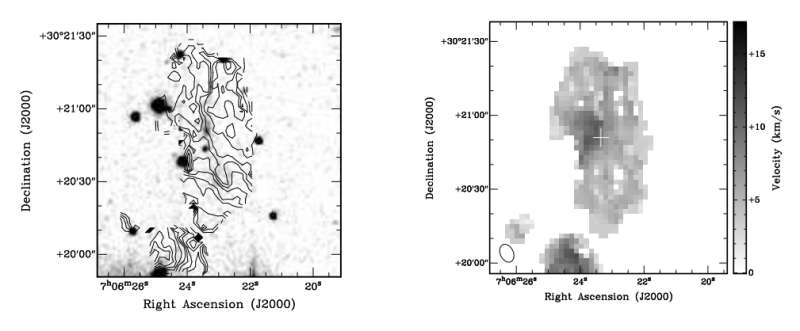November 8, 2016 report
Researchers discover UGC 3672 galaxy to be an unusual merging triplet of gas-rich dwarf galaxies

(Phys.org)—Astronomers from India and Russia revealed new information about the composition of the galaxy UGC 3672. According to a paper published Nov. 4 on the arXiv pre-print server, UGC 3672 is actually a triplet of very gas-rich dwarf galaxies in the process of merging.
UGC 3672 is located near the center of the nearby Lynx-Cancer intergalactic void. This void, which is about 59 million light years away from Earth, was recently a subject of detailed surveys due to its relative proximity. Lynx-Cancer gives scientists the opportunity to study galaxies to a much fainter mass and luminosity limit than have been done in more distant voids.
In September 2015, a team of researchers, led by Jayaram Chengalur of the National Center for Radio Astrophysic in Pune, India, conducted observations of UGC 3672 lasting approximately five hours. They used the Giant Metrewave Radio Telescope (GMRT) located near Pune to carry out hydrogen line (H I line) observations of UCG 3672 and also analyzed the optical photometry data available in the the Sloan Digital Sky Survey (SDSS) in order to study this peculiar galaxy in detail.
The data investigated by the team allowed them to draw conclusions that UGC 3672 is, indeed, a triplet of gas-rich dwarf galaxies.
"We find that UGC 3672 consists of an approximately linearly aligned triplet of gas rich dwarfs with large scale velocity continuity along the triplet axis," the scientists wrote in the paper.
According to the research, the faintest component of the triplet, designated UGC 3672A, is extremely gas-rich and also extremely metal deficient. UGC 3672B and UGC 3672C are significantly less gas-rich, four and six times less gas-rich respectively. It is also noteworthy that star formation is much more wide spread in 'B' and 'C' rather than in the 'A' dwarf.
Based on the observations, the astronomers assume that the location of the UGC 3672 system in an extremely low-density environment is not coincidental, but is rather a consequence of structure formation proceeding more slowly.
"We suggest that the location of this highly unusual system is not a coincidence but is related to the 'cosmic microscope and time machine' effects associated with voids," the paper reads.
Intergalactic voids are regarded by astronomers as such "cosmic microscopes and time machines" as they offer an opportunity to look at both the earlier stages of structure formation. Furthermore, voids allow probing smaller scales of the power spectrum than is probed by structures in dense regions.
The study also confirms that the so-called "wet" mergers (mergers between gas-rich galaxies) could produce gas-rich disks. The authors note that in the case of UGC 3672, the linear arrangement and velocity continuity of the galaxies in this system, along with the fact that the diffuse gas appears to be settling into a rotating disk, indicate that a wet merger with flow along filaments is a possible pathway for the formation of gas-rich disks.
"Our observations indicate that wet mergers of galaxies flowing along a filament is a possible pathway for the production of disk like systems," the researchers wrote.
More information: UGC 3672: An unusual merging triplet of gas-rich galaxies in the Lynx-Cancer void, arXiv:1611.01271 [astro-ph.GA] arxiv.org/abs/1611.01271
Abstract
We present HI 21cm and optical observations of UGC 3672 which is located near the centre of the nearby Lynx-Cancer void. We find that UGC 3672 consists of an approximately linearly aligned triplet of gas rich dwarfs with large scale velocity continuity along the triplet axis. The faintest component of the triplet is extremely gas-rich (MHI/LB ~ 17) and also extremely metal deficient (12+log(O/H) ~ 7.0). The metallicity of this dwarf is close to the 'floor' observed in star forming galaxies. Low resolution HI images show that the galaxy triplet is located inside a common HI envelope, with fairly regular, disk like kinematics. At high angular resolution however, the gas is found to be confined to several filamentary tidal tails and bridges. The linear alignment of the galaxies, along with the velocity continuity that we observe, is consistent with the galaxies lying along a filament. We argue that the location of this highly unusual system in an extremely low density environment is not a coincidence, but is a consequence of structure formation proceeding more slowly and also probing smaller scales than in regions with average density. Our observations also indicate that wet mergers of galaxies flowing along filaments is a possible pathway for the formation of gas rich disks. The UGC 3672 system provides an interesting opportunity to study the kind of interactions typical between high redshift extremely gas rich unevolved small systems that lie at base of the hierarchical galaxy formation model.
© 2016 Phys.org





















